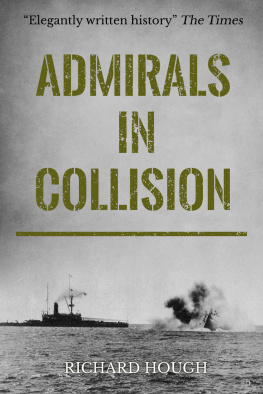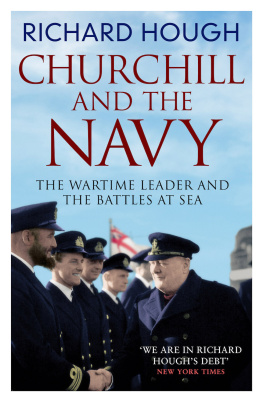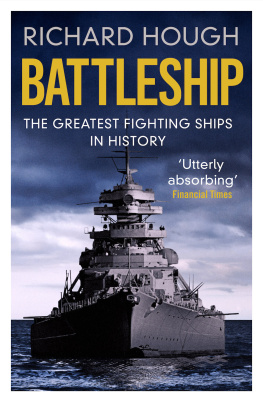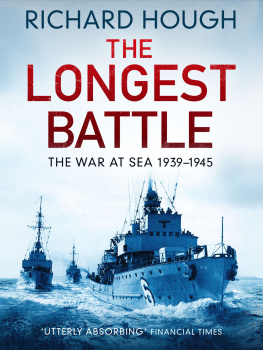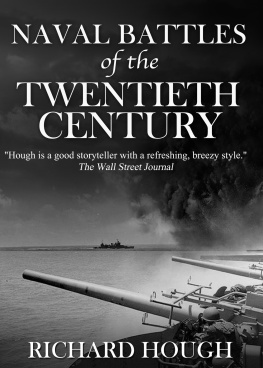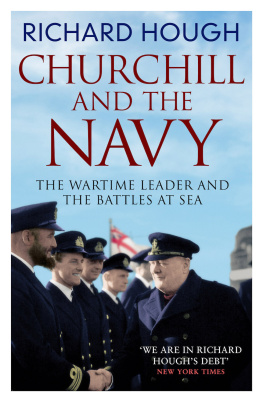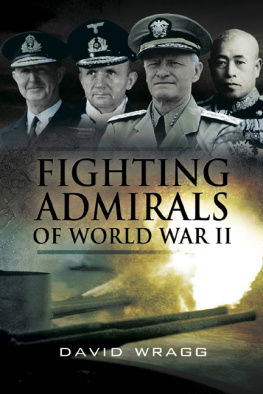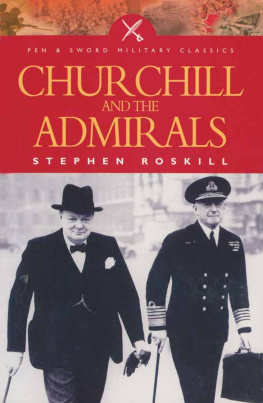Richard Hough - Admirals in Collision: The Saga of a Great Naval Disaster
Here you can read online Richard Hough - Admirals in Collision: The Saga of a Great Naval Disaster full text of the book (entire story) in english for free. Download pdf and epub, get meaning, cover and reviews about this ebook. year: 2019, publisher: Lume Books, genre: Non-fiction. Description of the work, (preface) as well as reviews are available. Best literature library LitArk.com created for fans of good reading and offers a wide selection of genres:
Romance novel
Science fiction
Adventure
Detective
Science
History
Home and family
Prose
Art
Politics
Computer
Non-fiction
Religion
Business
Children
Humor
Choose a favorite category and find really read worthwhile books. Enjoy immersion in the world of imagination, feel the emotions of the characters or learn something new for yourself, make an fascinating discovery.
- Book:Admirals in Collision: The Saga of a Great Naval Disaster
- Author:
- Publisher:Lume Books
- Genre:
- Year:2019
- Rating:4 / 5
- Favourites:Add to favourites
- Your mark:
- 80
- 1
- 2
- 3
- 4
- 5
Admirals in Collision: The Saga of a Great Naval Disaster: summary, description and annotation
We offer to read an annotation, description, summary or preface (depends on what the author of the book "Admirals in Collision: The Saga of a Great Naval Disaster" wrote himself). If you haven't found the necessary information about the book — write in the comments, we will try to find it.
Admirals in Collision: The Saga of a Great Naval Disaster — read online for free the complete book (whole text) full work
Below is the text of the book, divided by pages. System saving the place of the last page read, allows you to conveniently read the book "Admirals in Collision: The Saga of a Great Naval Disaster" online for free, without having to search again every time where you left off. Put a bookmark, and you can go to the page where you finished reading at any time.
Font size:
Interval:
Bookmark:
Admirals in Collision
Richard Hough
Richard Hough 1959
Richard Hough has asserted his rights under the Copyright, Design and Patents Act, 1988, to be identified as the author of this work.
First published in 1959 by Hamish Hamilton
This edition published in 2019 by Lume Books.
Table of Contents
Authors Note
WAR, runs the saying, is nine-tenths boredom and one-tenth hell; and peace, for a fighting service, has been called ten-tenths boredom. In the closing years of Queen Victorias reign, the Royal Navy had been at peace for three-quarters of a century, with no more than scattered skirmishes to occupy the time and exercise the theories, initiative and courage of officers and men. Having grown with Britains Empire and her responsibilities, the Royal Navy was also the most powerful force in the world, so strong that a single squadron could challenge any other nations entire navy. Britains ironclad fleets were the final expression of nineteenth-century power politics, feared abroad as they were loved with a possessive pride at home.
And yet there were some intelligent, far-sighted and ambitious officers who believed that the years of inactivity threatened to paralyse the Royal Navys administration, the principles of training, communications, tactics and of ship and weapon design, and so eventually to incapacitate the service as a weapon of war. These officers formed a vocal and powerful minority within the inner councils of the Admiralty. They were mostly regarded as eccentric and a nuisance. They were certainly intelligent, politically influential and entirely dedicated to their careers; qualities that were essential in order to break down the solidly-entrenched traditionalists. But Jackie Fishers massive Dreadnought navy of 1914, the only force that could have won or lost World War I in an afternoon, was the symbol and the actuality of their eventual victory.
This is a book about two admirals, who reached flag rank in the early stages of the new generations struggle for recognition. Both in character and in their service philosophy they were so antagonistic that they almost appear now as destined for explosive fusion. Their paths first crossed in 1888, in the Royal Navys widely publicized and important naval manoeuvres, which began off the Atlantic coast of Ireland, and which provided a unique opportunity for a courageous admiral to justify his unorthodoxy. They concluded in triumph for one and humiliating defeat for the other. Five years later these same officers met again, under the most dramatic and tragic circumstances, on other manoeuvres and on another sea. The causes of the catastrophe that followed are as mysterious, and have been almost as widely debated, as those of the enigma of the Marie Celeste .
In this book I have not tried to solve the case of the battleship H.M.S. Victoria . I have tried only to show how the strongly contrasting backgrounds, the personalities and the careers of the two men who were most closely involved in the catastrophe can lead to several possible conclusions. The truth of the Victoria , like the truth of the Marie Celeste and so many other mysteries of the sea, will never be known.
These, then, are the two admirals whose collision has caused so much controversy in naval circles over the past sixty-six years, as the small selection of comments by authorities on page 8 reveals.
CHAPTER ONE
He conducted his work so skilfully as to prove every admiral arrayed against him his inferior.
The New Tork Times
WAR was officially declared on July 24, 1888. The enemys intentions were clear from the start. He would attempt to break out from his fortified bases with his two squadrons, cut off Britains sea communications with the outside world, and destroy her harbours, ports and all other cities within range of his guns.
As the enemy Commander-in-Chief, Rear-Admiral Sir George Tryon, K.C.B., looked forward with relish to the task of bringing Britain to her knees. His headquarters were at Berehaven, in Bantry Bay, on the south-west coast of Ireland, and his flagship was the ironclad Hercules , a strongly armoured 8,000-ton masted battleship armed with massive 10-inch muzzle-loading guns. Under his command at Berehaven, Tryon had four more ironclads and cruisers and supporting light forces; while 250 miles away to the north-east at Lough Swilly, he had a further four battleships.
Pitted against Tryon were two British squadrons comprising in all thirteen ironclads and an almost overwhelming number of cruisers, all of which, even before the official declaration of war, had closed in and sealed him in his two bases. The odds were strongly against Tryon. The invading forces can confidently look forward to a resounding defeat should they have the temerity to show themselves beyond the range of their shore-based artillery, was a typical comment reflecting the trust Britain showed in her defending Navy. But Rear-Admiral Tryon held certain advantages which were not at once apparent to the uninitiated. Behind the safety of his forts at Berehaven and Lough Swilly, the timing, direction and method of any break-out were his. He was in constant telegraphic communication by land-line with his second-in-command on the north coast of Ireland. Above all, Tryon was an exceptionally able commander who possessed the imagination and ability to plan his strategy and tactics outside the strictly conservative principles accepted by the Royal Navy.
Tryon had demonstrated his initiative and set the tone of the operation from the beginning by clubbing himself the Achill Admiral, after a wild and rugged island mid-way between his bases. It was a name which carried the timbre of victory in its sound, and one which gave him an early moral advantage over his foe. In certain departments of the Admiralty, the use of this nickname was regarded as something akin to showmanship, and not altogether in the best taste. But even had he known, Sir George would not have been in the least concerned. To him peace-time manoeuvres were not a series of games with a strict code of rules and standards of sportsmanship; they were hill dress rehearsals for war, realistic and even bitter struggles between the opposing sides. In the war of 1888 he was to make an unorthodox and uncomfortable opponent.
Facing Tryon in this exercise of strength and skill, and in command of the defence of Britain, was Vice-Admiral John K. E. Baird; but the chief responsibility for keeping the Achill Fleet locked up in its base at Berehaven, rested with Commodore Albert Hastings Markham, who led the inshore squadron of cruisers. It was his task to watch every move of the ships of Tryons fleet, to close in and attack any that emerged, and hold them in combat until Bairds ironclads could close in for the kill. This was the most responsible command the forty-six-year-old Commodore had held, and in spite of the superiority of the blockading forces, he was not altogether confident that he could carry out his assignment successfully against the formidable Try on, whose reputation and powerful and colourful personality he found intimidating. With the close presence of Bairds ironclads to support him, the commander of the inshore blockading cruisers could, in theory, hardly fail in his task. But over-confidence was not a fault from which Bertie Markham suffered.
Although it had never been Sir George Try ons habit to discuss his plans with his subordinates, or even with his staff, he had completed his preparations for war long before Bairds ironclads had heaved to on a chill, choppy ocean off Berehaven, and Markhams cruisers had begun their patrol just outside his base. He would lie comfortably in harbour, take his own time, create false alarms, worry and harass without serious intent, and finally, when the blockaders were worn out, and sick of the cry of Wolf, wolf, make the actual attempt to break the blockade. By the afternoon of the 24th, it was as thick as pea soup and blowing a gale of wind, one correspondent reported; and Try on contemplated the discomfort of his blockaders with satisfaction. He had been hoping that some really dirty weather would come up to add to the difficulties of Baird and Markham. That night, or perhaps the next, he would send a torpedo-boat or two out to keep Markhams nerves on edge. Meanwhile, for the next few days his own officers could relax and enjoy themselves, riding or shooting over the hills of County Cork. Scarcely a day passed that we did not get ashore for a good walk amongst the beautiful scenery of the Emerald Isle, and wonder why so few ever visit its grand and beautiful west coasts, observed Rear-Admiral J. N. East of the Warspite , who also found the children lovely specimens; although a more jaundiced reporter for The Times wrote of the peasantry, Their cabins are squalid and their habits piggish.
Next pageFont size:
Interval:
Bookmark:
Similar books «Admirals in Collision: The Saga of a Great Naval Disaster»
Look at similar books to Admirals in Collision: The Saga of a Great Naval Disaster. We have selected literature similar in name and meaning in the hope of providing readers with more options to find new, interesting, not yet read works.
Discussion, reviews of the book Admirals in Collision: The Saga of a Great Naval Disaster and just readers' own opinions. Leave your comments, write what you think about the work, its meaning or the main characters. Specify what exactly you liked and what you didn't like, and why you think so.

